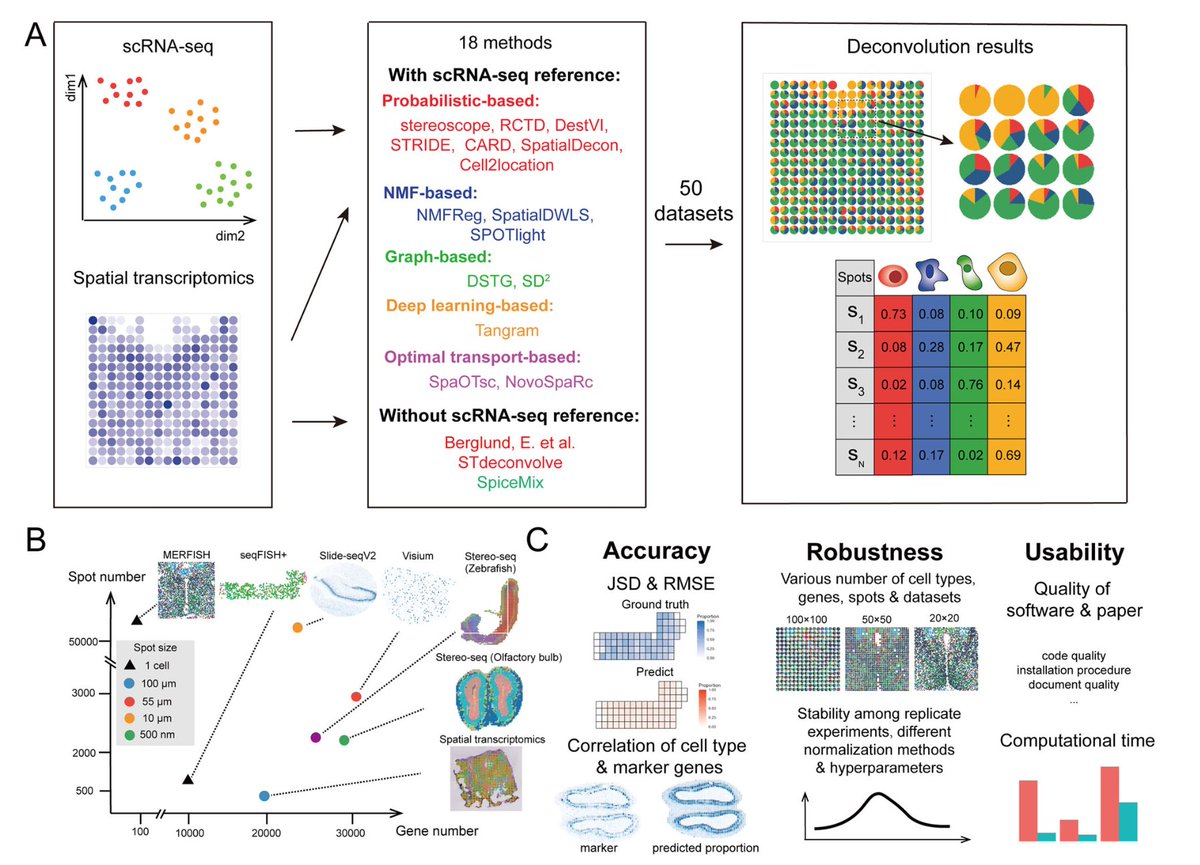Discover and read the best of Twitter Threads about #SpatialTranscriptomics
Most recents (6)
Do you need to analyze Spatial Transcriptomics data, but are lost in the endless sea of methods?
Here's an explainer of the new @NatureComms paper benchmarking 18 spatial cellular deconvolution methods🧵🧵
nature.com/articles/s4146…
Here's an explainer of the new @NatureComms paper benchmarking 18 spatial cellular deconvolution methods🧵🧵
nature.com/articles/s4146…

This thread is organized as follows:
1️⃣ Intro to Spatial Transcriptomics
2️⃣ Intro to Cellular Deconvolution
3️⃣ Methods benchmarked
4️⃣ Datasets used (real & simulated)
5️⃣ Performance assessment
6️⃣ Benchmarking results
7️⃣ Accuracy
8️⃣ Robustness
9️⃣ Usability
🔟 Guidelines
1️⃣ Intro to Spatial Transcriptomics
2️⃣ Intro to Cellular Deconvolution
3️⃣ Methods benchmarked
4️⃣ Datasets used (real & simulated)
5️⃣ Performance assessment
6️⃣ Benchmarking results
7️⃣ Accuracy
8️⃣ Robustness
9️⃣ Usability
🔟 Guidelines
1️⃣ What is Spatial Transcriptomics & why is it important?
Spatial Transcriptomics (Method of the Year 2020) is a fast evolving field.
It holds great potential to further our understanding of development & disease, by placing cells in their spatial native tissue context.
Spatial Transcriptomics (Method of the Year 2020) is a fast evolving field.
It holds great potential to further our understanding of development & disease, by placing cells in their spatial native tissue context.
Excited to announce our new method #CytoSPACE for mapping single cells from a reference atlas to #SpatialTranscriptomics (ST) data at high resolution, out now in @NatureBiotech! 1/10
nature.com/articles/s4158…
nature.com/articles/s4158…
🚨New #SpatialTranscriptomics #Bioinformatics data resource out in @naturemethods.
SODB, a platform with >2,400 manually curated spatial experiments from >25 spatial omics technologies & interactive analytical modules.
This🧵will walk you through all the features of SODB [1/33]
SODB, a platform with >2,400 manually curated spatial experiments from >25 spatial omics technologies & interactive analytical modules.
This🧵will walk you through all the features of SODB [1/33]

First, some background.
Spatial technologies complement classical genomics by also providing information about spatial context & tissue organization in:
- embriogenesis
- disease development
- normal tissue homeostasis
The field has exploded 🔥 in the past 2 years. [2/33]
Spatial technologies complement classical genomics by also providing information about spatial context & tissue organization in:
- embriogenesis
- disease development
- normal tissue homeostasis
The field has exploded 🔥 in the past 2 years. [2/33]

But, data from different studies is stored in different configurations/repositories, such as:
- GEO
- zenodo
- fig share
- SingleCellPortal
- IONPath for MIBI
- 10XGenomics website
This makes data sharing & re-analysis challenging.
Databases exist, but have limitations. [3/33]
- GEO
- zenodo
- fig share
- SingleCellPortal
- IONPath for MIBI
- 10XGenomics website
This makes data sharing & re-analysis challenging.
Databases exist, but have limitations. [3/33]
Amazing week for #DeepLearning in #spatial #singlecell biology, with 2🔥new Graph Neural Networks methods!
1.STELLAR🇺🇸 @jure: a cell type annotation & discovery atlas-type framework
2.NCEM🇪🇺 @fabian_theis: an approach to infer cellular communication patterns
Deep dive below🧵
1.STELLAR🇺🇸 @jure: a cell type annotation & discovery atlas-type framework
2.NCEM🇪🇺 @fabian_theis: an approach to infer cellular communication patterns
Deep dive below🧵

But first, some background.
Spatial molecular biology has actually been around since the 70s. @lpachter's wonderful book-like article "Museum of Spatial Transcriptomics" comprehensively discusses history, tech & methodology advances in the past 50 years.
nature.com/articles/s4159…
Spatial molecular biology has actually been around since the 70s. @lpachter's wonderful book-like article "Museum of Spatial Transcriptomics" comprehensively discusses history, tech & methodology advances in the past 50 years.
nature.com/articles/s4159…
Nevertheless, recent advances in single cell molecular technologies (brought by e.g. @10xGenomics & @AkoyaBio) have facilitated the high-throughout profiling of (groups of) single cells in their tissue context across embryogenesis, normal tissue development & disease progression.
Excited to share that our @NatureBiotech paper with Aviv Regev on Multicellular Programs (MCPs) is now out with a fully automated data-driven method to identify MCPs from #singlecell or spatial data #behindthepaper: go.nature.com/3iQ8fgW nature.com/articles/s4158… (1/19) 

My highlights of the @10xGenomics #Xperience2021 event. The list of products keeps growing, I would highlight Chromium Connect as an underappreciated tool to bring the products up another level of throughput. Important as with #NGS, it won't take long to go from n=1 to n=96+. 

#CellPlex species-agnostic multiplexing up to 12 samples: not dissimilar to products such as TotalSeq, but baked-in so that it's been tested to work with the rest of the workflow. 

Going close to 1M cells, the #ChromiumX brings about 100x fold throughput increase, all marked with 'HT' in the Kits. I'd be interesting to know how the different #BodyAtlas projects embrace this and for what. 






